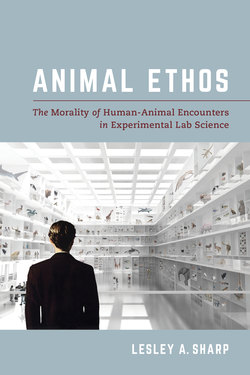Animal Ethos

Реклама. ООО «ЛитРес», ИНН: 7719571260.
Оглавление
Lesley A. Sharp. Animal Ethos
Отрывок из книги
Animal Ethos
The Morality of Human-Animal Encounters in Experimental Lab Science
.....
Whereas the rules that govern notions of human-animal difference may be regarded within their respective social contexts as reflecting cultural “truths,” they also flag ambiguities, uncertainties, and anxieties. As anthropologists have long known (Bateson 1972; Douglas 1966, 1970; Evans-Prichard 1940; Leach 1964; Lévi-Strauss 1963, 1969), interspecies boundaries are especially ripe in this regard because their integrity hinges on the ability to assert and maintain criteria that may well enable human “pre-eminence.” Ingold’s assertions are informed by long-established ethnographic projects, in which it is not unusual to encounter the blurring of interspecies boundaries, a sensibility widely documented, for instance, in pastoral societies. One discerns this in an assortment of disciplinary classics: E.E. Evans-Pritchard, for example, coined “the bovine idiom” to underscore how deeply enmeshed human lives were with cattle among the Nuer of southern Sudan (1940); June Nash has described in moving terms the affective dimensions of Quechua- and Aymara-speaking miners’ attachments to llamas during underground ritual sacrifices in Bolivia (1973, 1979); and Ingold’s own work exemplifies the intricacies of human-animal existence among Lapland reindeer herders (1980). A logic of interspecies intimacy will likewise be familiar to readers with pets or non-human companions, or to those who labor alongside working animals. Such relationships are not so much “encounters” as intimately entwined, morally inflected, and even troubled ways of being in the world (Haraway 2008).
Laboratory animals entail special problems, though, and a rendition of Ingold’s question What is a laboratory animal? provokes us in other ways. The literature that strives to answer such a question is replete with certain assertions and assumptions. Barbara Noske, an animal activist-anthropologist, describes the “object status” (1997, viii) of animals in commercialized contexts, asserting that lab animals are commodified creatures who occupy the outer edge of a continuum she dubs the “animal industrial complex,” a domain likewise inhabited by other creatures exploited by corporatized food production.8 As Noske reflects on these contexts, she offers an insight relevant to my own project, namely, that “unlike the animal food industry, which to a certain extent remains accessible to the general public, animal research tends to take place almost completely hidden from the public eye … behind closed doors and thick walls” (1997, 35).9 As we shall see, the hidden nature of animal labs bears with it repercussions not only for public perceptions, but also for its ability to inspire moral introspection among the humans who work there.
.....